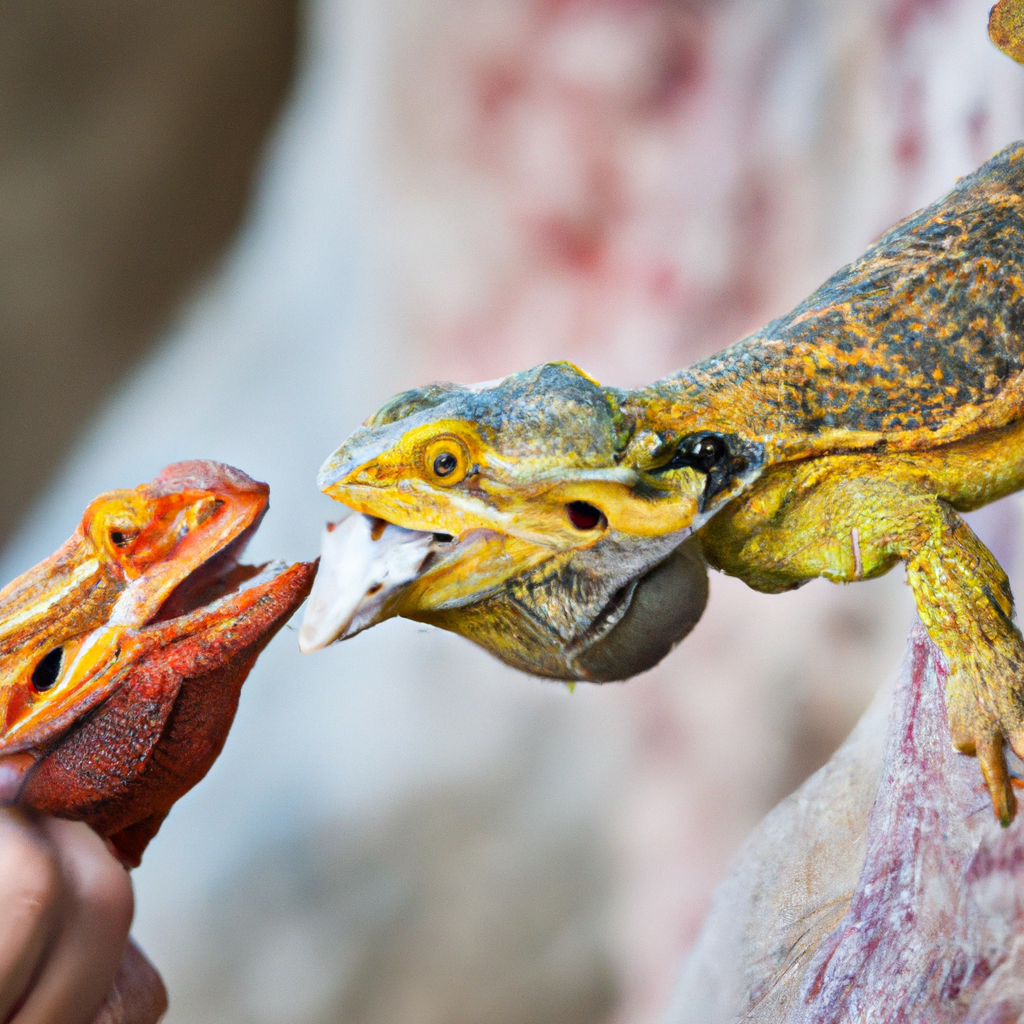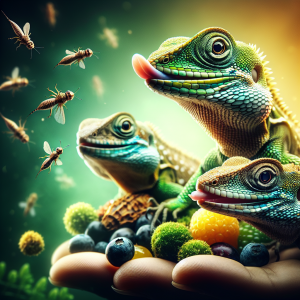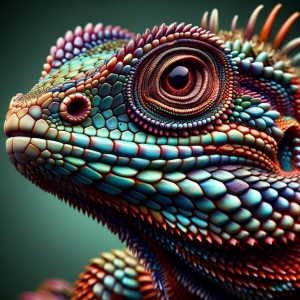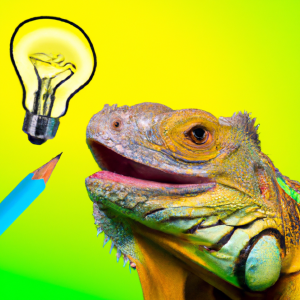Understanding the Importance of Enrichment for Lizards
Have you ever noticed the way lizards interact with their environment? It’s fascinating to see how these creatures respond to various stimuli and experiences. Enrichment plays a crucial role in keeping our scaly friends healthy and engaged.
Let me share a personal anecdote with you. A few years ago, I had the opportunity to visit a reptile sanctuary where I witnessed firsthand the impact of enrichment activities on lizards. One particular lizard, a bearded dragon, caught my attention with its playful behavior as it explored a specially designed enrichment area. It was evident how these activities stimulated the lizard’s mind and provided both physical and mental stimulation.
Enrichment is not just about keeping lizards entertained; it also contributes to their overall well-being. By incorporating elements that mimic their natural habitat, such as climbing structures, hiding spots, and foraging opportunities, we can help lizards lead fulfilling lives in captivity.
Understanding the importance of enrichment for lizards allows us to create a more enriching environment for our scaly companions. It’s not just about adding toys or decorations to their enclosure; it’s about providing them with opportunities to exhibit natural behaviors and engage their senses.
So, the next time you observe your lizard exploring its habitat or showing signs of curiosity, consider how you can enhance their environment further. By incorporating enrichment activities tailored to their species and individual preferences, you can ensure that your lizard remains healthy, happy, and mentally stimulated.
Enrichment is a key aspect of responsible lizard care, and by prioritizing it, we can make a positive impact on the well-being of these incredible creatures. Let’s dive deeper into the world of teaching lizards enrichment recognition and discover how we can improve their lives through engaging activities and experiences.
Benefits of Teaching Enrichment Activities to Lizards
I have always been fascinated by the idea of teaching enrichment activities to lizards. It’s such a unique concept, don’t you think? I mean, who would have thought that lizards could benefit from enrichment just like any other pet?
Did you know that providing enrichment activities for lizards can offer numerous benefits for their physical and mental well-being? It’s not just about keeping them entertained; it’s about enhancing their quality of life in captivity. When I first learned about this, I was amazed at how such simple activities could make a significant difference in a lizard’s life.
Imagine creating a stimulating environment for your lizard where they can engage in natural behaviors, explore new things, and stay active. It’s like giving them a little piece of the wild right in their own habitat. Plus, observing their reactions to different enrichment activities can be so rewarding. You start to notice their personalities shining through, their curiosity piqued, and their overall happiness levels increase.
One practical tip I’ve learned along the way is to tailor enrichment activities to your specific lizard species. Each species has its own preferences and behaviors, so it’s essential to provide activities that cater to their natural instincts. For example, basking spots, climbing structures, and hiding places can be great options for different types of lizards. By understanding your lizard’s needs and interests, you can create a customized enrichment plan that will keep them engaged and thriving.
So, have you ever thought about how enriching your lizard’s environment could impact their overall well-being? It’s not just about adding a few toys here and there; it’s about promoting their physical health, mental stimulation, and emotional happiness. Next time you interact with your lizard, consider how you can incorporate enrichment activities to make their life more fulfilling and enjoyable.
Recognizing Signs of Enrichment in Your Lizard
Have you ever noticed how your lizard reacts differently to certain activities or stimuli in its environment? It’s fascinating to observe these subtle cues that indicate whether your pet is truly benefiting from the enrichment you provide.
One interesting fact about recognizing signs of enrichment in lizards is that each lizard may display unique behaviors or preferences. For example, some lizards may become more active and curious when given new toys or climbing structures, while others may show contentment by basking under a heat lamp or exploring different textures in their enclosure.
When I first started implementing enrichment activities for my lizard, I was unsure of what to look for to determine if he was enjoying them. Over time, I learned to pay attention to his body language, such as increased exploration, hunting behaviors, or relaxed basking positions. These subtle changes in behavior helped me understand what types of enrichment he found most engaging.
As you observe your lizard, consider the broader implications of enrichment on their overall well-being. Providing opportunities for mental stimulation and physical activity through enrichment can help prevent boredom, reduce stress, and promote natural behaviors. By recognizing the signs of enrichment in your lizard, you can tailor their environment to better meet their needs and enhance their quality of life.
So, the next time you interact with your lizard, take a moment to observe their behavior closely. Are they showing signs of curiosity, engagement, or relaxation? These subtle cues can be valuable indicators of how well your lizard is responding to the enrichment activities you provide. Keep experimenting with different enrichment options and observe how your lizard’s behavior evolves over time – it’s a rewarding journey of discovery for both you and your scaly companion.
Best Practices for Implementing Enrichment for Lizards
When it comes to implementing enrichment for your lizards, it’s all about creating an engaging and stimulating environment that caters to their natural behaviors and instincts. Think of it as setting up a lizard playground where they can explore, forage, climb, and bask just like they would in the wild.
Now, let me share a personal anecdote that highlights the importance of providing enrichment for lizards. I once had a bearded dragon named Spike who seemed a bit lethargic and uninterested in his surroundings. After researching the benefits of enrichment, I decided to introduce new elements to his enclosure, such as a variety of branches for climbing and hiding spots for privacy. To my surprise, Spike’s demeanor completely changed – he became more active, curious, and visibly content. It was a clear indication that the enrichment activities were making a positive impact on his well-being.
One practical tip I can offer when implementing enrichment for your lizards is to rotate their enrichment items regularly. Just like humans, lizards can get bored with the same environment and activities. By introducing new elements, switching up hiding spots, or adding different textures for them to explore, you can keep their interest piqued and provide ongoing mental and physical stimulation.
Remember, the goal of enrichment is to enhance your lizard’s quality of life, promote natural behaviors, and reduce stress or boredom. By investing time and effort into creating a dynamic and enriching environment for your lizards, you’ll not only keep them happy and healthy but also deepen your bond with these fascinating reptiles.
Creating an Enriching Environment for Your Lizard
Have you ever wondered how to create an enriching environment for your lizard? Picture this: your lizard basking under a heat lamp, exploring a variety of textures and surfaces in their habitat, and engaging in activities that stimulate their natural behaviors. This visual alone can spark your creativity when setting up an enriching space for your scaly friend.
When it comes to creating an enriching environment for your lizard, think about the different elements that can enhance their physical and mental well-being. Consider incorporating a variety of hiding spots, climbing structures, and basking areas to cater to their natural instincts. Lizards love to explore and interact with their surroundings, so providing a diverse environment can keep them engaged and stimulated.
One practical tip to keep in mind is to research your lizard’s species-specific needs. Different lizard species have unique preferences when it comes to their habitat, so understanding your lizard’s natural behaviors and requirements is key to designing an enriching space. For example, arboreal lizards may appreciate vertical climbing structures, while ground-dwelling lizards may prefer burrowing opportunities.
Another important aspect to consider is the safety of the enrichment items you introduce to your lizard’s habitat. Ensure that all decorations, plants, and materials are non-toxic and pose no risk of injury to your lizard. Regularly inspect and clean the habitat to maintain a healthy and enriching environment for your scaly companion.
By creating an enriching environment tailored to your lizard’s needs, you are not only promoting their physical health but also enriching their mental and emotional well-being. Imagine the joy and curiosity your lizard will exhibit as they explore and interact with their enriched habitat. So, get creative, think like a lizard, and design a space that will keep your reptilian friend happy and thriving!
Engaging Enrichment Ideas for Lizard Education
Have you ever tried setting up a lizard obstacle course? It may sound quirky, but it’s actually a fun and enriching activity for your scaly friend. Picture this: miniature bridges, tunnels, and climbing structures strategically placed in your lizard’s habitat, creating a stimulating playground for them to explore.
Lizards are natural climbers and love to navigate different terrains, making an obstacle course an exciting way to engage their instincts and provide mental and physical stimulation. Not only does it keep them active, but it also encourages natural behaviors like problem-solving and exploration.
When designing your lizard’s obstacle course, consider their species and size to ensure the elements are safe and suitable for them. Incorporate a variety of textures, heights, and challenges to keep them engaged and entertained. You can use branches, rocks, PVC pipes, and other reptile-safe materials to construct the course, allowing your lizard to practice their agility and coordination.
Observing your lizard navigate through the obstacle course can be both entertaining and rewarding. You’ll witness their natural behaviors, adaptability, and problem-solving skills in action. It’s a great way to bond with your pet while providing them with an enriching experience that promotes their overall well-being.
So, why not put your creativity to the test and design a customized obstacle course for your lizard? Not only will it keep them mentally and physically active, but it will also add an element of excitement to their daily routine. Who knew teaching enrichment activities to lizards could be this much fun?
Monitoring and Evaluating Enrichment Success
Have you ever wondered how to tell if your lizard is truly benefiting from the enrichment activities you’ve set up for them? It’s like playing detective, observing their behavior and looking for those subtle signs that indicate they’re thriving in their enriched environment.
One practical tip I’ve found helpful is to keep a journal or log to track your lizard’s reactions to different enrichment stimuli. Note down any changes in their activity levels, exploration behaviors, or feeding habits after introducing new enrichment items or activities. This can help you evaluate what’s working well and what may need adjustment.
By monitoring and evaluating your lizard’s response to enrichment, you can fine-tune their environment to better suit their preferences and needs. It’s all about creating a tailored enrichment plan that enhances their physical and mental well-being.
Remember, every lizard is unique, so what works for one may not work for another. The key is to be patient and observant, allowing your lizard to show you what types of enrichment they enjoy the most. It’s a fun and rewarding journey of discovery that strengthens the bond between you and your scaly friend.
So, next time you set up a new enrichment activity for your lizard, pay attention to how they interact with it. Are they more active, curious, or content? These subtle cues can tell you a lot about whether your efforts are making a positive impact on their overall well-being. Keep experimenting, keep observing, and most importantly, keep enriching your lizard’s life!
Enhancing Your Lizard’s Well-being through Enrichment
Enrichment activities for lizards are not only fun for your scaly friends but also essential for their well-being. As we wrap up our discussion on enhancing your lizard’s life through enrichment, let’s consider the broader implications of investing time and effort into creating a stimulating environment for your pet.
Imagine this – you come home after a long day, and your lizard greets you with a happy wiggle or a playful climb. That moment of connection and interaction is priceless, and it’s all thanks to the enriching experiences you’ve provided for your pet. But beyond the immediate joy of seeing your lizard thrive, there are deeper benefits to consider.
By actively engaging in enrichment activities and recognizing the positive changes in your lizard’s behavior, you’re not just fostering a stronger bond with your pet – you’re also promoting their physical and mental health. Enrichment helps reduce stress, prevent boredom, and encourage natural behaviors, ultimately leading to a happier and healthier lizard.
But here’s a thought-provoking question for you: How can we continue to innovate and improve enrichment practices for lizards? As our understanding of animal behavior and welfare evolves, so too should our approach to enriching the lives of our scaly companions. Perhaps there are new techniques, toys, or environments waiting to be discovered that could take lizard enrichment to the next level.
So, as you reflect on the impact of enrichment on your lizard’s life, consider how these simple yet meaningful activities can have far-reaching effects. From promoting physical fitness to stimulating mental acuity, the benefits of enrichment extend beyond just a fun pastime – they are fundamental to your lizard’s overall well-being. Keep exploring, experimenting, and observing your lizard’s reactions to different enrichment opportunities, and watch as your bond with your pet grows stronger with each enriching experience.




